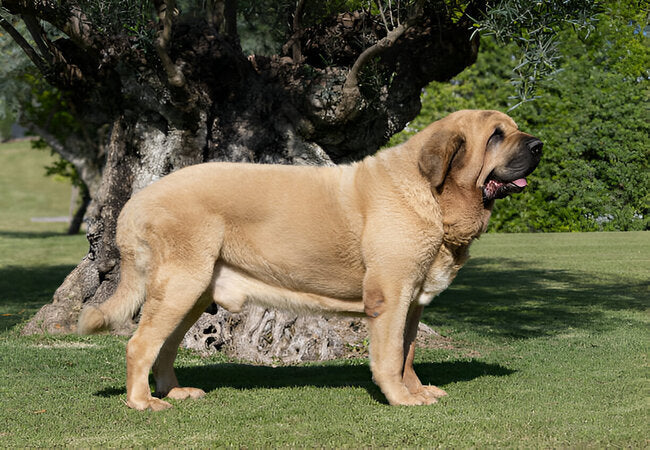Spanish Mastiff Guide 2025: Vet-Approved Care for Gentle Giant Guardians 🐾🛡️

In this article
🛡️ Spanish Mastiff Guide 2025: Gentle Giant Guardian with Loyal Heart & Heritage
By Dr. Duncan Houston BVSc
📜 Ancient Origins & Heritage
The Spanish Mastiff (Mastín Español) is one of the world’s oldest guardian breeds, tracing back to Roman times when shepherds used them to protect flocks on the Iberian Peninsula. From medieval transhumance traditions to modern-day working farms, they’ve guarded against wolves and bears, often wearing protective metal collars called carlancas.
They were formally recognized by the FCI in 1946, with a revival of traditional lines in the 1980s. The AKC added them to the Foundation Stock Service in 2008. Though rare outside Spain, their gentle popularity is growing.
🐕 Size, Appearance & Physical Traits
- Height: 28–35 in males; 26–32 in females
- Weight: 140–200 lb (some up to 220 lb)
- Coat: Short, dense double coat—moderate shedding
- Colors: Fawn, brindle, black, wolf-gray, yellow, often with white markings
- Body: Powerful, broad head with loose skin and dewlap; muscular build suited to protective roles
- Lifespan: 10–12 years
🧬 Health Screening & Common Conditions
Spanish Mastiffs are generally healthy, but their large size and working background create specific concerns:
- Hip Dysplasia & Arthritis: Common due to size; annual vet checks advised
- Elbow Issues: Occasional; screening recommended
- Gastrointestinal Health: Prone to bloat—use slow-feeder bowls, avoid excessive post-meal activity
- Heat Sensitivity: Thick coat and drooping features make them susceptible; provide shade & hydration
- Addison’s Disease: Rare, but symptoms like lethargy and GI upset should prompt vet screening
- Obesity: Regular weight monitoring important due to large structure
Annual exams including orthopedic, cardiac, and gastrointestinal screening are essential.
🎭 Temperament & Behavior Science
Calm, dignified, and deeply loyal to their family, Spanish Mastiffs are watchful but seldom overly vocal . Early socialization helps curb wariness of strangers and prevents territorial aggression . They are independent thinkers—requiring firm and consistent guidance .
Intelligent and food-motivated, they learn best with positive reinforcement and structure . Despite their size, they are patient and gentle with children when properly introduced .
👪 Family Fit & Social Needs
- Ideal home: Large yards with secure fencing; not suited to apartments
- Experience: Best for seasoned owners familiar with giant breeds
- Children & Pets: Good with respectful older kids; early introductions help with smaller pets
- Guarding & Protection: Excellent watchdogs; strong guarding instincts require balance and training
🏃 Exercise, Training & Enrichment
- Exercise: ~60 minutes daily—brisk walks, secure yard ROM, slow play
- Training: Positive reinforcement in puppy classes; consistency more effective than dominance-based methods
- Mental Enrichment: Puzzle feeders, scent games (Purrz), territorial recall drills (Woopf™)
Start gentle ground work early to support joint health and handling.
🧼 Grooming & Hygiene
Despite their size, grooming is manageable:
- Brush weekly; more during seasonal shedding
- Monthly baths to clean skin folds and reduce odor & drool stains
- Keep neck folds dry; wipe drool cloths regularly
- Trim nails monthly; clean ears weekly; brush teeth daily
🍽️ Nutrition & Feeding Strategy
Feed quality large-breed formula designed for giant dogs. Split into two meals to aid digestion and avoid bloat.
- Caloric intake: ≈3–4 cups/day depending on activity
- Include joint supplements (glucosamine, chondroitin)
- Provide clean, fresh water; limit treats to <10% of calories
🏥 Preventive Veterinary Care
- Annual exams: orthopedic, cardiac, dental, skin, and GI evaluation
- Blood panels including thyroid, liver, Addison’s markers
- Vaccination & parasite protocols
- Discuss weight management plan with vet
🧳 Travel & Climate Considerations
- Car and crate training early; test tolerance before flights
- Stay cool in summer—provide shade & frozen water toys
- Thrives best in temperate climates; coat protects in cold
✅ Dr Houston’s Spanish Mastiff Wellness Checklist
- 📆 Puppy training & socialization before 14 weeks
- 🏃 60 min daily exercise + mental games
- 🧼 Weekly grooming, daily drool/fold care
- 🧬 Annual health screenings: joints, GI, bloodwork
- 🎯 Woopf™ for obedience & recall; Purrz for mental care
- 📱 Use Ask A Vet for injury, behavior, or heat-stress support
🎬 Pop‑Culture & Modern Recognition
Though overshadowed by Mastiff cousins, the Spanish Mastiff appeared in recent breed roundups celebrating Spain's native dogs . They’ve served film studios in European countryside scenes, valued for their imposing, serene presence—and actor Viggo Mortensen owns one named “Alatriste” .
🌟 Final Summary & Lifestyle Fit
The Spanish Mastiff merges ancient guardian instincts with a peaceful, loyal nature—best suited for experienced homes with space and firm routine. When offered daily exercise, expert vet oversight, training, and affectionate structure, this gentle giant thrives, offering unwavering protection, companionship, and presence for years to come.
Need expert guidance for your Spanish Mastiff? Visit AskAVet.com or download the Ask A Vet app for round‑the‑clock vet-backed support. 📱🐶






